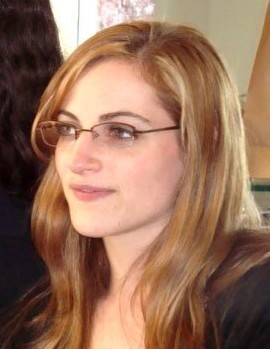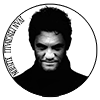- Hits: 357
 Nome: Katherine Blackwell
Nome: Katherine Blackwell
Age: 25
Place of Birth: LA California
Black Cat aka Didi: Hi Katherine, Tell us a little about yourself…(Do you have an occupation other than Artist?
Are you married, single, children, pets etc? All you want to tell about you…)
Katherine Blackwell:
When I’m not paintings, I manage an art supply store in Charlotte, NC. I’m married to the best most supportive husband ever, and I have two cat’s and the cutest god-son named Havok (he’s in three of my paintings although still in my friend Regina’s belly at the time). If I’m not painting or working, I’m reading, a lot.
B.C.: Tell us about your art, the mediums that you work with and how you like to work…
K.B.: I paint a series of surrealistic figures that melt into themselves and each other. I use the imagery to translate emotions into the visual. My medium is Oil paints with a generous amount of Liquin. My technique is mostly glazing, each paintings contains about 60 thin layers of paint on top of a acrylic under painting.
B.C.: Do you have a "typical" or preferred way of approaching a painting? What rituals do you use to put yourself in the mood to paint?
K.B.: My process usually starts during a photo shoot for my next round of paintings. Sometimes I’ll have an idea of what I want before hand, but usually I’ll fall in love with a pose my model does, or the way the light reflects off a part of the body and I’ll know I have to paint it. Once I’ve figured out the emotion I want to portray, I’ll start painting, keeping that idea in mind as I go. Sometimes it turns out completely different than I imagined it in my head. Once I start adding in the strands and playing with how I want the body parts and different images in the piece to connect to each other, the panting starts taking on a life of its own and I just go with it. I don’t usually have any rituals to put myself in the mood to paint. I almost always want to paint, all day every day. If I’m having a creative block, or I’m just mentally drained, sometimes it helps if I buy some new colors of paint, or new brushes to test out. While I paint I listen to audio books, so If I buy a new audio book, that helps me want to paint too.
B.C.: What particular message (if any) are you trying to convey with these images, or are they no more than a reflection of the subject matter?
K.B.: I think it is both. For me it is a reflection of my mind using a subject that everyone can relate to, their body. This is how I seen the world, or feel the world. Since I’m a visual person, when I feel anything emotionally, it automatically translates in my head to the visual. If you could see an emotion, this is what it would look like, at least in my head. I’ve always imagined these strands to be that feeling that connects us to other people, or ourselves. Generally in my paintings I use three forms of symbolism, a giant hand usually shows the mental state, A body to show the actions and the strands to show how it all connects. That’s the message that I want to convey, is that somehow we do all connect.
 B.C.: You seem to be a very prolific painter, and your works seem to be filled with intense emotion. Is painting like a release for you or is it emotionally draining?
B.C.: You seem to be a very prolific painter, and your works seem to be filled with intense emotion. Is painting like a release for you or is it emotionally draining?
K.B.: Painting is definitely a release. It’s very obvious when I don’t get to paint for an extended period of time. All these thoughts and ideas just built up in my head with no outlet. I painted a piece based off this experience called “Pressures of the Non-Blinking Third Eye” It shows a person screaming with strands coming out of their head from where the third eye is traditionally shown to be. That’s what it feels like when I can’t paint. During the process of painting, I’m listening to a book or music, so half my mind is on that activity and the other half is on the canvas in front of me. This forces me to filter out every thought in my head except where to put the next brush stroke.
B.C.: One of the first things I noticed about your work, was your understanding and knowledge of the human form and anatomy. Has the figure always been a central element to your art
K.B.: Figures have been a what I’ve always been drawn to. I was a dancer for 12 years, this gave me a great love of how the body can move and what amazing things it can do given strength and much practice. When I was younger, I loved drawing people. I would try to draw people out of fashion magazines, and for the longest time thought I wanted to be a fashion designer. I would make sure that I filled up one page a night with drawings of people in clothes. At some point I realized I didn’t really care about the clothes, I just liked the drawing part. When I sketched at school, it would be either portrait’s of people around me, or people with designs attached to them, or giant eyeballs coming off their bodies. That’s where this series started was from all these weird little sketches of people and spider webs meeting and joining into different things. The figure has always been one of the most beautiful things in the world to me, and I’ve always enjoyed more than any other subject trying to mimic that beauty and further understand it through art.
B.C.: Why are the recurrent subjects of your paintings almost always female images?
K.B.: There are a couple of reasons. The biggest one is because I am a female. The paintings are about me and my thoughts or emotions, so although the figures are not me personally, it’s still a self portrait in essence. I also find that generally the female figure is far more interesting to paint then males. There are more curves, mixed with hard edges that the male form doesn’t have. I’ve used a couple males for images where I thought a male figure would work better than a female, and I have a few ideas of where I could use a male figure in the future, but mostly I just like painting the female from more.
 B.C.: What relationship is there between the dark art and the female icons?
B.C.: What relationship is there between the dark art and the female icons?
K.B.: That’s a hard question, I’ve never thought much about it before. The darkness in the painting helps make the lighter aspects more evident. I love the idea of a vast empty dark space for these figures to be in. In a world that’s so chaotic with emotion, it’s like taking a snap shot of one and putting it in a observation room, where it can be studied without outside influences seeping in and tainting your perspective.
The females are there by chance, the darkness and the female components of the piece are not something I’ve consciously put together as a deeper message. I would love to hear someone’s interpretation on this however; one of my favorite parts about showing my work to other people is to see how they see it. A lot of times I find a truth in what they see that I missed.
B.C.: Can any of your characters be considered a self-portrait?
K.B.: Like I mentioned before, they are all a self-portrait of my thoughts. One day I might take the plunge and use myself as a model, then it will truly be a self portrait.
B.C.: What dark artistic passions or obsessions do you have or see in your work?
K.B.: The only thing I can think of would be that as much as I love to recreate the human form, I love to manipulate it even more. Painting exactly what’s in front of you can become boring after awhile, but with my series I only paint it realistically up to a certain point. The rest of the painting I get to play with the human form and shape it however I want.
B.C.: What is the biggest mistake you have ever made as an artist? What did you learn from it?
K.B.: When I was first teaching myself how to paint in oils I did so using landscape images. One of these pictures was a large black and white picture of a town right on the ocean. I didn’t have much time to paint and a lot of what I did, I did over until I got it right. Six months into the painting my husband was looking at it and pointed out that the entire right hand side of the painting’s perspective was off by a lot. It took me another three month’s to fix this huge mistake and finish the paintings. From then on, I always make sure to check my proportions and how close the items are to the reference photo frequently. Now I don’t make more than several brush strokes without checking my reference photo. Unless you have a photographic memory, there is no way your mind can process exactly what something looks like, unless you look at it.
B.C.: Who are some of the current working artists that inspire you, and any artists that you would love to collaborate with?
K.B.: My favorite current artist is Jenny Saville, her ideas and techniques are amazing. I’ve never thought much about collaboration.
B.C.: What are your plans for the future and the next exhibitions? Your dreams?
K.B.: I plan on staying with this series for as long as ideas come from it, which at this point seems endless. I plan on going to the artexpo in Toronto in 2011 to reach a broader market. In October I have a solo show in NY at An American Craftsman Gallery. My dream is to be able to live completely off my art, and to be able to travel the world doing so.
B.C.: Thank you, Katherine. It has been a pleasure to interview an artist like you!
xLegion gallery: Katherine Blackwell
Follow Didi on Fabook: https://www.facebook.com/didi.ferri





